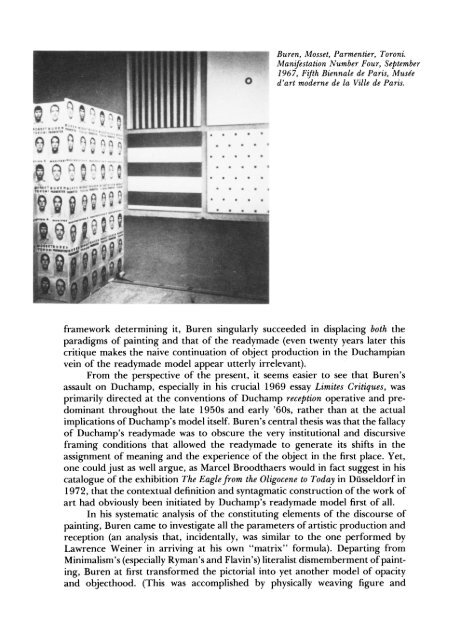Buchloh, conceptual art.pdf - Course Materials Repository
Buchloh, conceptual art.pdf - Course Materials Repository
Buchloh, conceptual art.pdf - Course Materials Repository
Create successful ePaper yourself
Turn your PDF publications into a flip-book with our unique Google optimized e-Paper software.
ftkw-%<br />
l ft<br />
VW v , W<br />
? fl"<br />
Is:<br />
1% S;<br />
forf,_<br />
wX,<br />
Buren, Mosset, Parmentier, Toroni.<br />
Manifestation Number Four, September<br />
1967, Fifth Biennale de Paris, Musie<br />
d'<strong>art</strong> moderne de la Ville de Paris.<br />
framework determining it, Buren singularly succeeded in displacing both the<br />
paradigms of painting and that of the readymade (even twenty years later this<br />
critique makes the naive continuation of object production in the Duchampian<br />
vein of the readymade model appear utterly irrelevant).<br />
From the perspective of the present, it seems easier to see that Buren's<br />
assault on Duchamp, especially in his crucial 1969 essay Limites Critiques, was<br />
primarily directed at the conventions of Duchamp reception operative and predominant<br />
throughout the late 1950s and early '60s, rather than at the actual<br />
implications of Duchamp's model itself. Buren's central thesis was that the fallacy<br />
of Duchamp's readymade was to obscure the very institutional and discursive<br />
framing conditions that allowed the readymade to generate its shifts in the<br />
assignment of meaning and the experience of the object in the first place. Yet,<br />
one could just as well argue, as Marcel Broodthaers would in fact suggest in his<br />
catalogue of the exhibition The Eagle from the Oligocene to Today in Dfisseldorf in<br />
1972, that the contextual definition and syntagmatic construction of the work of<br />
<strong>art</strong> had obviously been initiated by Duchamp's readymade model first of all.<br />
In his systematic analysis of the constituting elements of the discourse of<br />
painting, Buren came to investigate all the parameters of <strong>art</strong>istic production and<br />
reception (an analysis that, incidentally, was similar to the one performed by<br />
Lawrence Weiner in arriving at his own "matrix" formula). Dep<strong>art</strong>ing from<br />
Minimalism's (especially Ryman's and Flavin's) literalist dismemberment of painting,<br />
Buren at first transformed the pictorial into yet another model of opacity<br />
and objecthood. (This was accomplished by physically weaving figure and
















